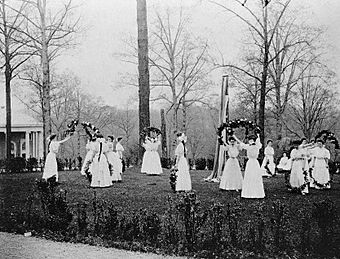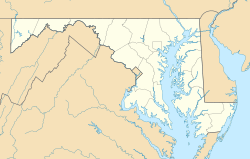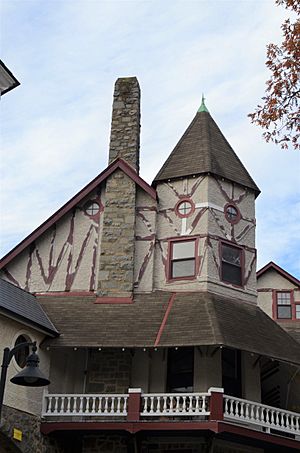National Park Seminary facts for kids
Quick facts for kids |
|
|
National Park Seminary Historic District
|
|

May Day festivities at National Park Seminary in 1907
|
|
| Location | Linden Lane near I-495, Forest Glen Park, Maryland |
|---|---|
| Area | 23 acres (9.3 ha) |
| Built | 1890 |
| Architect | Emily Elizabeth Holman |
| Architectural style | Late 19th and early 20th century American movements, late 19th and 20th century revivals, Greek revival |
| NRHP reference No. | 72000586 |
| Added to NRHP | September 14, 1972 |
National Park Seminary was a special private school for girls. It was open from 1894 to 1942. Later, it was known as National Park College. The school was located in Forest Glen Park, Maryland. Its name came from the nearby Rock Creek Park. Today, this historic campus is being saved. It is becoming the center of a new neighborhood with homes.
Contents
A School with Unique Buildings
How the School Started
The land where the school stood was first a summer resort. It was called "Ye Forest Inne" and opened in 1887. People from Washington, D.C. came here to relax. But the resort did not make enough money. So, the property was sold to new owners.
In 1894, it became a "finishing school" for young women. A finishing school taught girls social skills and arts. The first class had 48 female students.
Amazing Architecture
The school campus was known for its many different building styles. It had fun and unusual designs. Besides typical Victorian styles, there were buildings that looked like they came from other countries.
Many of these small, international-style homes were built for student groups called sororities. All of them were designed by architect Emily Elizabeth Holman. She was from Philadelphia, Pennsylvania. The campus also had covered walkways, outdoor statues, and beautiful gardens. In 1936, the school changed its name to "National Park College." It started to focus on more modern education. It remained one of the best schools for women in the country.
A New Purpose: Helping Soldiers
Becoming a Military Hospital
When World War II began, the United States Army needed more places to care for injured soldiers. In 1942, the Army bought the school property. It became a medical center for soldiers who were hurt. This meant the college had to close.
The Army paid $890,000 for the land and buildings. It became part of Walter Reed Army Hospital. It was called the Walter Reed Forest Glen Annex. The goal was to give injured soldiers a quiet, green place to get better. It was also close to the main hospital.
After the Wars
After World War II and the Korean War, the U.S. Army tried to keep the place nice. But they had less money. Some of the unique sorority houses were used as homes for military officers. These officers and enlisted soldiers helped take care of the campus.
However, the Army lost funding from the U.S. Congress in the 1960s and 1970s. They could no longer afford to maintain the property. So, they decided to give it up. They planned to transfer it to another government agency to find a new owner.
Saving a Historic Place
Protecting the Campus
On September 14, 1972, the National Park Seminary Historic District was recognized. It was listed as a national historic district. This meant it was an important historical site.
But in the years that followed, the property was not well cared for. It suffered from neglect and vandalism. For example, the beautiful Odeon Theater, built in the Greek Revival style, was destroyed by a fire in 1993.
Local groups decided to act. "Save Our Seminary" (SOS) was formed in 1988. In the late 1990s, Senator Paul Sarbanes helped a lot. He encouraged the Army to fix some buildings. He also helped release the property for new development. With money from private donations, SOS started fixing the pagoda in 1999. This project was finished in 2003.
New Homes for the Future
In 2003, a company called Alexander Company started a new plan. They wanted to save the campus. They planned to make it the center of a new neighborhood. This new neighborhood has townhomes, condominiums, and apartments.
The townhomes come in many different styles. Some look like Spanish mission homes, others are colonial. The apartments are in the main school building. Some of these apartments are affordable housing. Condominiums are in other buildings. These include the Senior House, Senior Annex, Music Hall, Chapel, and Aloha House. The plans for this new development were even featured in a 2006 New York Times story.
Some parts of the old seminary grounds were used for new townhomes. Building started in 2006. Some parts of the old forest were cut down for the new homes. But other parts were saved. Also, some of the historic yards and courts were protected from being redeveloped.
Images for kids
- National Park Seminary Historic District, Montgomery County, at Maryland Historical Trust










